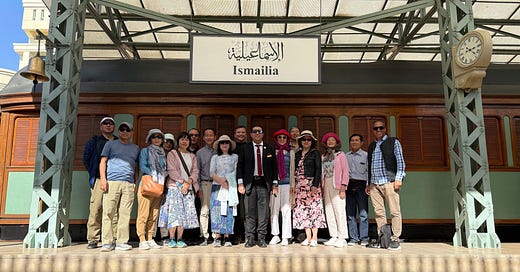At the Gate of Glory: Who Owns the Suez Canal
Curators at the Suez Canal Museum tried to address
We stopped at the front entrance where a grand statue of Ferdinand de Lesseps, the father of the modern Suez Canal, once stood, bold, immovable, and gazing eastward across the desert he helped divide.
But he’s no longer there.
His statue was removed in 1956 (although now in Suez Canal Museum in Ismailia we visited today), just before the Suez Crisis, and has never returned. That absence, strangely enough, said more than the statue ever could.
Inside the Suez Canal Museum, we were met not with silence, but with an exuberant curator, part historian, part performer, part philosopher.
With unfiltered passion, he danced through 3,000 years of Nile Valley naval tradition, tracing Egypt’s maritime soul from the days of Pharaonic fleets to the Suez Kapudan of the Ottoman Empire. He told stories of ancient nose-breaking rituals to prevent the souls of kings from returning, of god Sobek the crocodile spirit protecting the Nile, and of convoys and canals that formed lifelines through sand and time.
But as he spoke of ownership, the undertone shifted.
He didn’t say it explicitly, but it echoed between his jokes and gestures:
This canal is Egyptian. Always was. Always will be.
In the West, we’re told that the Suez Canal is a marvel of French ambition, European engineering, and 19th-century diplomacy.
And yes, Ferdinand de Lesseps, a French diplomat without formal engineering credentials, did rally international investors, secure Khedive Ismail’s blessing, and oversee the construction from 1859 to 1869.
But what gets omitted too easily are the 1.5 million Egyptian laborers, of whom tens of thousands died. The forced labor, the imperial economics, and the fact that the British soon took control, using the canal as a colonial choke point until Nasser reclaimed it in 1956.
So, whose canal is this really?
Yesterday’s canal was a symbol of imperial access, Europe’s shortcut to India, its lifeline to oil, its assertion that geography was only real estate waiting to be claimed.
Even de Lesseps’ vision, though bold, was embedded in a system that treated land and labor as expendable. He wanted his name carved into history, not shared with the souls who dug it.
Today, the canal is run by Egypt’s Suez Canal Authority, a pillar of national pride and revenue. The curator made sure we knew that the "Ever Given" crisis in 2021, which blocked the canal for six days, was handled not by outside intervention, but by Egyptian grit, engineering, and leadership.
The pride was palpable.
You could feel it in his voice when he said,
“We opened this canal once. We expanded it twice. And we protect it always.”
Ownership today isn’t a statue. It’s the knowledge of how the system works, the tools to fix it, and the confidence to say no one else will do it for you.
The question isn’t just who owns the Suez Canal today.
It’s what does it mean to own something so powerful tomorrow?
- Is it a trade route?
- A geopolitical fault line?
- A symbol of identity?
- A cash flow?
- A lesson?
Maybe the Suez Canal teaches us that true ownership comes not with first construction but with continuous reinvention.
As I am writing about being bold in transition, I often mean choosing growth over certainty, presence over prestige. But this visit reminded me that boldness isn’t always innocent.
Sometimes, boldness has consequences.
Sometimes, it takes without asking.
And sometimes, it must be taken back.
So I stood at the gate, where the statue of Ferdinand de Lesseps once loomed, and I didn’t mourn its absence. I saw its silence as an invitation:
The future of the Suez Canal belongs to those who can navigate not only ships, but stories.
Kefei/Koffee in Cairo




